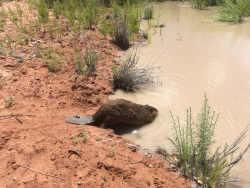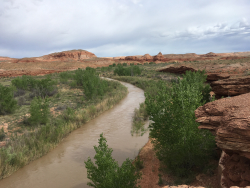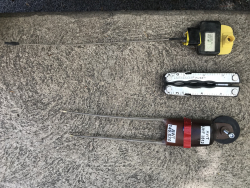
Courtesy & © Emma Doden, Photogrphr.
 The beaver’s powerful hands and tail which are used to build dams in Utah’s desert rivers.
The beaver’s powerful hands and tail which are used to build dams in Utah’s desert rivers.
Courtesy & © Emma Doden, Photogrphr.
 Emma Doden, graduate student in the Department of Wildland Resources in the Quinney College of Natural Resources at USU conducting radio telemetry to find the location of both resident and translocated beavers.
Emma Doden, graduate student in the Department of Wildland Resources in the Quinney College of Natural Resources at USU conducting radio telemetry to find the location of both resident and translocated beavers.
Courtesy & © Emma Doden, Photogrphr.
 Quarantine Pen – Once a beaver is caught it is placed in quarantine for three days before translocated so it will not spread disease. The beaver is kept cool, well fed, and close to water.
Quarantine Pen – Once a beaver is caught it is placed in quarantine for three days before translocated so it will not spread disease. The beaver is kept cool, well fed, and close to water.
Courtesy & © Emma Doden, Photogrphr.
 Adult beaver being released into Utah desert rivers after they have been equipped with radio-transmitter and PIT-tags in their tails. Researchers can then use radio telemetry to track the movement of the beavers.
Adult beaver being released into Utah desert rivers after they have been equipped with radio-transmitter and PIT-tags in their tails. Researchers can then use radio telemetry to track the movement of the beavers.
Courtesy & © Emma Doden, Photogrphr.
 Adult beaver being released into Utah desert rivers after they have been equipped with radio-transmitter and PIT-tags in their tails. Researchers can then use radio telemetry to track the movement of the beavers.
Adult beaver being released into Utah desert rivers after they have been equipped with radio-transmitter and PIT-tags in their tails. Researchers can then use radio telemetry to track the movement of the beavers.
Courtesy & © Emma Doden, Photogrphr.
 San Rafael River: a tributary of the Green River which runs through some of the driest parts of Utah.
San Rafael River: a tributary of the Green River which runs through some of the driest parts of Utah.
Courtesy & © Emma Doden, Photogrphr.
 Processing a beaver kit,
Processing a beaver kit,
Courtesy & © Emma Doden, Photogrphr.
 Radio transmitters: The types of radio transmitters which are attached to the beaver’s tails so researchers can monitor its movement.
Radio transmitters: The types of radio transmitters which are attached to the beaver’s tails so researchers can monitor its movement.
Courtesy & © Emma Doden, Photogrphr.The Price and San Rafael rivers flow through some of Utah’s driest areas. Both are tributaries of the Green River. These rivers are essential to sustain the wildlife, riparian vegetation, native and endangered fish populations, and livestock that live in Utah’s eastern desert.
Beavers, native to both rivers, have far-reaching impacts on these waterways because of their ability to build dams which hold the water on the arid landscape – they are nature’s aquatic engineers.
One beaver dam can improve the living conditions for a host of fish, insects, plants, birds and mammals who live in and around the river.
Emma Doden, a graduate student in the Department of Wildland Resources in the Quinney College of Natural Resources at USU is working to understand the dynamics of beavers who are translocated to desert rivers for restoration purposes and how they compare to the naturally-occurring resident beavers who are already established.
Doden explains, “I help relocate nuisance beavers to desert river systems to give them a second chance, and help restore the river for the imperiled and endangered fish species…in this arid climate.”
Currently, Doden’s work is “passive desert river restoration” because there is no machinery manipulating the landscape or man-made structures impacting the research results. She is relying solely on beavers and their resources which have been part of the rivers’ ecosystems for millions of years. The beavers’ engineering teeth, tails, and paws build dams and lodges from riparian vegetation, gravel and mud.
Many of the translocated beavers come from the USU Beaver Rehabilitation and Relocation Center which captures nuisance beavers, quarantines them for three days to ensure they cannot spread disease, then passes them to Doden to be released in the desert system.
Nate Norman, a field biologist in the USU Ecology Center who helps operate the Beaver Rehabilitation and Relocation Center said, “Working with Paul Chase from the US Forest Service we have trapped and relocated approximately 8 to 10 beavers from around Cache Valley [in northern Utah, to the desert rivers in Doden’s research.“
Both the resident and translocated beavers in the study receive a radio-transmitter and PIT-tag in their tail.
Doden explains, “The PIT-tag is similar to the microchip [a] dog or cat gets at the vet for identification if it ever gets lost. We use radio-transmitters and PIT-tags to track the movements of our beavers so they do not become lost after release.”
To this point, 90% of the translocated beavers have moved outside Doden’s research area as they explored their new habitat. They were probably searching for a companion and a suitable place to build a home.
This travelling increases the beaver’s vulnerability to predators since they have no underground burrow or lodge for protection. During the 2019 field season, of the eight beavers released, three of the translocated beavers were taken by predators.
Many of the tributaries of the Green and Colorado rivers are wood-deprived because of changes in the river flow due to human extraction. To increase a translocated beaver’s chances of surviving and its likelihood of remaining where it’s placed, the research team has proposed building simple dam-like structures out of wood fence posts, which would encourage the beavers to stay where they’re released. Once they receive NEPA approval the structures will be built.
Doden adds, “Our project goals are already being met, as we are learning so much about the fate of translocated beavers in desert ecosystems. Restoration goals will also be met if even a few beavers stay in the study area and build dams, supplementing the resident beaver population and creating more complex habitat for imperiled desert fish to live.”
This is Shauna Leavitt and I’m Wild About Utah.
Beaver in Utah’s Desert Rivers-Credits:
Photos: Courtesy & © Emma Doden
Lead Audio: Courtesy and © Friend Weller
Text: Shauna Leavitt, Utah Cooperative Fish and Wildlife Research Unit, Quinney College of Natural Resources, Utah State University
Beaver in Utah’s Desert Rivers-Additional Reading
Greene, Jack, Rosy Finches, Wild About Utah, March 11, 2019, https://wildaboututah.org/rosy-finches/
Leavitt, Shauna, Proposed Beaver Holding Facility in Millville, Utah, Wild About Utah, September 3, 2018, https://wildaboututah.org/proposed-beaver-holding-facility-in-millville-utah/
Hellstern, Ron, Leave it to Beaver, Wild About Utah, July 30, 2018, https://wildaboututah.org/leave-it-to-beaver/
Goodwin, Jim, Riparian Zones and a Critter Quiz, Wild About Utah, June 15, 2015, https://wildaboututah.org/riparian-zones-and-a-critter-quiz/
Kervin, Linda, Huddling for Warmth, Wild About Utah, February 3, 2011, https://wildaboututah.org/huddling-for-warmth/
Strand, Holly, Beavers: The Original Army Corps of Engineers, Wild About Utah, April 29, 2010, https://wildaboututah.org/beavers-the-original-army-corps-of-engineers/
Ramsey, R. Douglas, Banner, Roger E., McGinty, Ellie I. Leydsman, Watershed Basins in Utah, USU Extension, https://extension.usu.edu/rangelands/ou-files/RRU_Section_Four.pdf
Restoring Degraded Waters, One Pest at a Time, Utah State Magazine, Utah State University, December 7, 2021, https://utahstatemagazine.usu.edu/environment/restoring-degraded-waters-one-nuisance-at-a-time/
